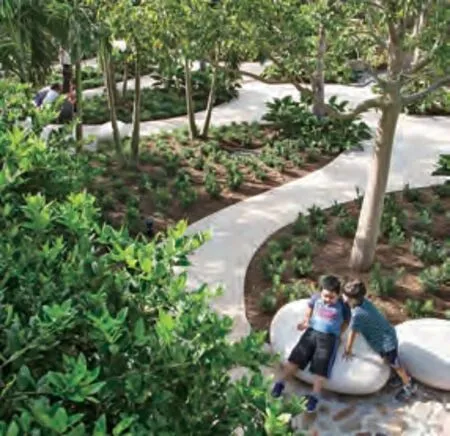健康景观

在经历了持续3年的疫情,感受了干旱、山火、暴雨等越来越凸显的气候变化,目睹了COP26为全球各国减排、控制全球变暖不超过1.5 ℃的博弈谈判,健康成为我们每个人关心的话题。人们都更加关注人类生存星球的健康、生态系统的健康、城市的健康、社会的健康以及个体的健康。面对高密度的城市环境、快节奏的生活方式,人们更期待繁忙之余沉浸在自然中来获得压力缓解,这表明生态基础设施的高效能运转与绿色生活方式的促进对于城市居住环境健康的维系至关重要。
人类社会在历史发展过程中从未停止通过营造景观为自身的健康生存服务,比如工业化过程中对公共卫生系统的持续改善、广泛的城市公园运动等。尽管如此,当下突发的疫情给全球城市公共卫生带来了重大挑战,极大影响了人们对绿色生活方式倡导与健康促进的关注,同时,日趋严峻的老龄化社会挑战,急需健康适老环境的建设。对儿童或少年来说,现代科技的进步和社会生活的变化已经重构了新的生活经历,要为他们提供更多接触自然的机会,促进他们身心健康发展,培养创造力、冒险精神和社会互动等能力。当然,其他特殊群体也需要我们给予更多的关注,例如,我们需要为高压人群在城市中提供能够获得身心恢复的场所,以便他们能更加健康地工作和生活。
毫无疑问,城市绿色空间塑造的景观与人类的身心健康紧密关联。同时,传统生物医学模式向“生物-心理-社会-环境”多维医学模式的转变,也进一步促进社会大众对居住环境的重视。新的整体医学观更加注重综合治疗模式,尤其是针对大量慢性疾病患者,需要通过营造良好的居住环境和改变生活习惯等干预才能获得更好的疗愈效果。在过去的几十年里,基于心理和生理之间联系的研究逐渐深入,我们进一步了解到接触自然景观,会对人类的健康带来积极影响。许多的研究证明了在自然环境中更有利于人的情绪平复和血压降低,工作表现和解决问题的能力也更优秀,居住在绿色自然环境周边的居民,身体健康水平更好,幸福指数更高,等等。
这些研究凸显了城市中自然系统的重要性,风景园林师更需要考虑如何从空间格局与绿地质量上思考城市绿色环境与人们居住、生活、工作与休憩的关联,让更多的生活境域被绿色环境所浸润,构建健康景观系统。然而,在高质量发展要求下,城市绿地服务健康的功效也仍然存在一些亟待解决的问题,比如我们应该如何规划、设计和管理我们所处的居住环境,使其在满足基本功能需求的同时发挥重要的健康促进作用?什么类型的景观能够最有效地促进健康?如何评估促进健康所需要的景观阈值?哪些接触途径可以有效促进健康?虽然对健康景观的评价以及效能评估仍处于探索阶段,但是,正如医学的发展进入“循证”阶段,健康景观的塑造与效能的发挥也需要加快推进循证的途径。
目前倡导的“公园城市”为大众创造幸福、健康和舒适的绿色环境提供了探索。许多城市已经拥有了上千座公园,成为名副其实的公园之城。一些城市逐步拆除公园围墙:北京朝阳区计划对50多个城区公园陆续完成“拆栏”;上海宣布部分公园将24 h开放。打开大门的公园更好地与城市功能、市民生活融合在一起,对人们的休闲与健康促进提供了更多的便利。让绿地融入城市的目的就是要让生态基础设施发挥最高效能的生态调节功能,不仅是要好看,而且要好用,如调节城市的暴雨、径流,降低城市的热岛效应,形成健康的城市生态系统。
未来,城市人口将继续增长,对土地、住房、食物、交通和就业等方面的需求持续增加,这无疑将进一步加剧环境安全、精神压力,甚至疾病等一系列影响健康的城市问题。在此背景下,风景园林师需要积极地从多种维度探讨景观和健康的关系,挖掘未来通过景观促进健康的更多可能十分必要。

Landscape for Health
After experiencing the pandemic that has lasted for 3 years,feeling the increasingly prominent climate changes, such as droughts,mountain fires and heavy rains, and witnessing the gaming and negotiation in COP26 for global countries to reduce their emissions and control the global warming under 1.5℃, we see that health has become a topic of concern for all of us.People are paying more attention to the health of the human-living Planet, the health of ecosystems, the health of cities, the health of societies and the health of individuals.Facing high-density urban environments and fastpaced lifestyles, people are looking forward to immersing themselves in nature to relieve their stress after their busy schedules.This indicates that the efficient operation of ecological infrastructure and the promotion of green lifestyles are crucial to maintaining a healthy urban living environment.
Throughout history, human societies have never ceased to serve their own healthy survival by creating landscapes.For example,humans made the continuous improvement of public health systems and implemented widespread urban park movements during industrialization.Nevertheless, the current outbreak of the pandemic has imposed a critical challenge to the global urban public health, while greatly affecting people’s advocacy of green lifestyles and their attention to health promotion.In the meantime, the increasingly severe challenges of an aging society urgently require the construction of healthy and age-friendly environments.For children or adolescents, advances in modern technology and shifts in social life have reconstructed new life experiences; so it is necessary to provide them with more opportunities to contact the nature, so as to promote their healthy physical and mental growth and to foster their creativity, adventurousness and social interaction, among other competencies.Of course, other special groups also need more attention from us.For example, we need to provide places in cities for high-pressure people’s physical and mental recovery,so that they can work and live in a healthier manner.
Undoubtedly, the landscapes shaped with urban green space are closely associated with humans’ physical and mental health.Meanwhile,the traditional biomedical model is shifting to the “bio – psycho– social – environmental” multidimensional medical model, thus further driving the public to attach more importance to their living environment.The new holistic view of medicine focuses more on the integrated treatment model.Especially, a large number of patients with chronic diseases require such interventions as creating a good living environment and changing lifestyle habits to achieve better healing results.Over the past few decades, with gradually intensified research on the linkage between psychology and physiology, we have further understood that exposures to the natural landscape will deliver positive effects on human health.As demonstrated by many studies, a natural environment is conducive to calmer moods and lower blood pressures,as well as better work performance and problem-solving abilities.In addition, those who live around green natural environments have better physical health and higher levels of well-being.
These studies highlight the significance of natural systems in cities.Landscape architects are required to consider the association between urban green space and people’s dwelling, living, working and resting in terms of spatial patterns and green-space qualities, so that more living realms are infiltrated with green environments and more healthy landscape systems are constructed.Under the requirements of high-quality development, however, some pressing issues still exist with the health efficacy of urban green-space services.For instance,how to plan, design and manage our living environment, so that it can play an important health-promoting role while meeting the basic functional needs? What types of landscapes are most effective in promoting health? How to assess the landscape thresholds needed for promoting health? And what exposure pathways can effectively promote health? Although the evaluation of healthy landscapes and their effectiveness is still in an exploratory stage, the shaping of healthy landscapes and the play-out of their effectiveness entail acceleration of promoting evidence-based approaches, just as the development of medicine has entered the “evidence-based” stage.
“Park City” currently being advocated have made some explorations in creating a happy, healthy and comfortable green environment for the public.Many cities have already featured thousands of parks, making them a veritable city of parks.Some cities are gradually dismantling their park walls: Chaoyang District in Beijing plans to “remove the fences” of more than 50 urban parks; Shanghai has announced that some of its parks will be open 24 hours a day.Parks that have their gates opened would be better integrated with cities’functions and citizens’ lives, providing more convenience for promoting people’s leisure and health.The purpose of integrating green space into cities is to enable the ecological infrastructure to perform its ecological regulation function at the most effective level, so that such space would not only look beautiful, but also function well.For example, it can regulate rainstorms and runoffs across cities and diminish urban heatisland effects, so as to form a healthy urban ecosystem.
In the future, the urban population will keep growing,thus delivering more intense demands on land, housing, food,transportation and employment.This will undoubtedly further exacerbate a series of urban problems affecting health, such as environmental safety, mental stress and even disease.In this context,landscape architects are required to actively explore the relationship between landscape and health in multiple dimensions, and it becomes urgently necessary to seek for more possibilities of promoting health through landscape in the future.
Editor-in-Chief: Professor ZHENG Xi
January 7, 2023

